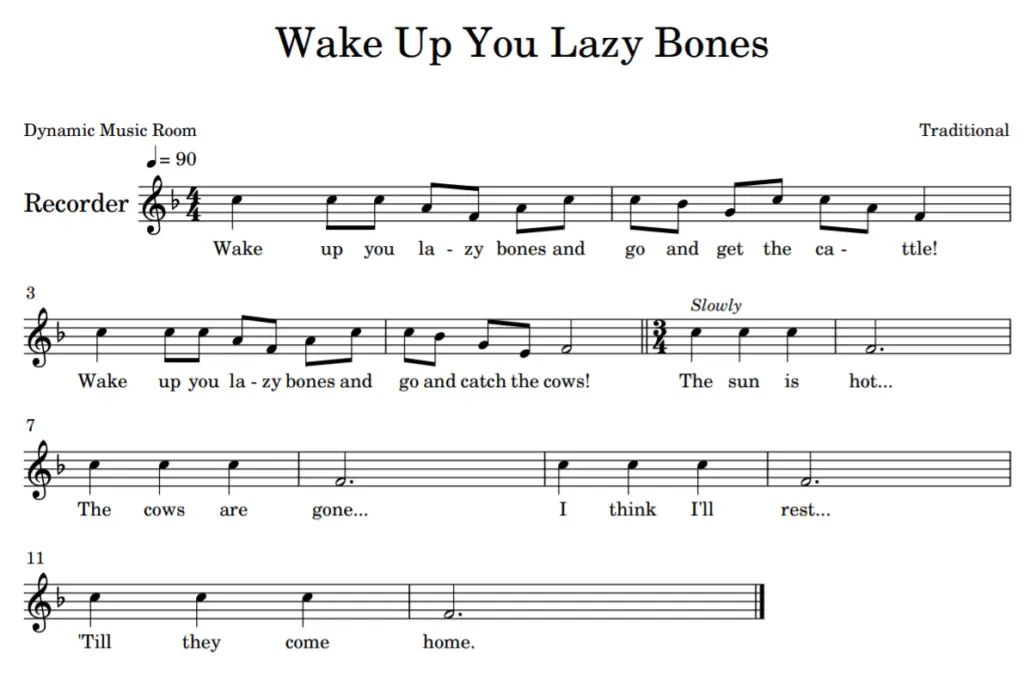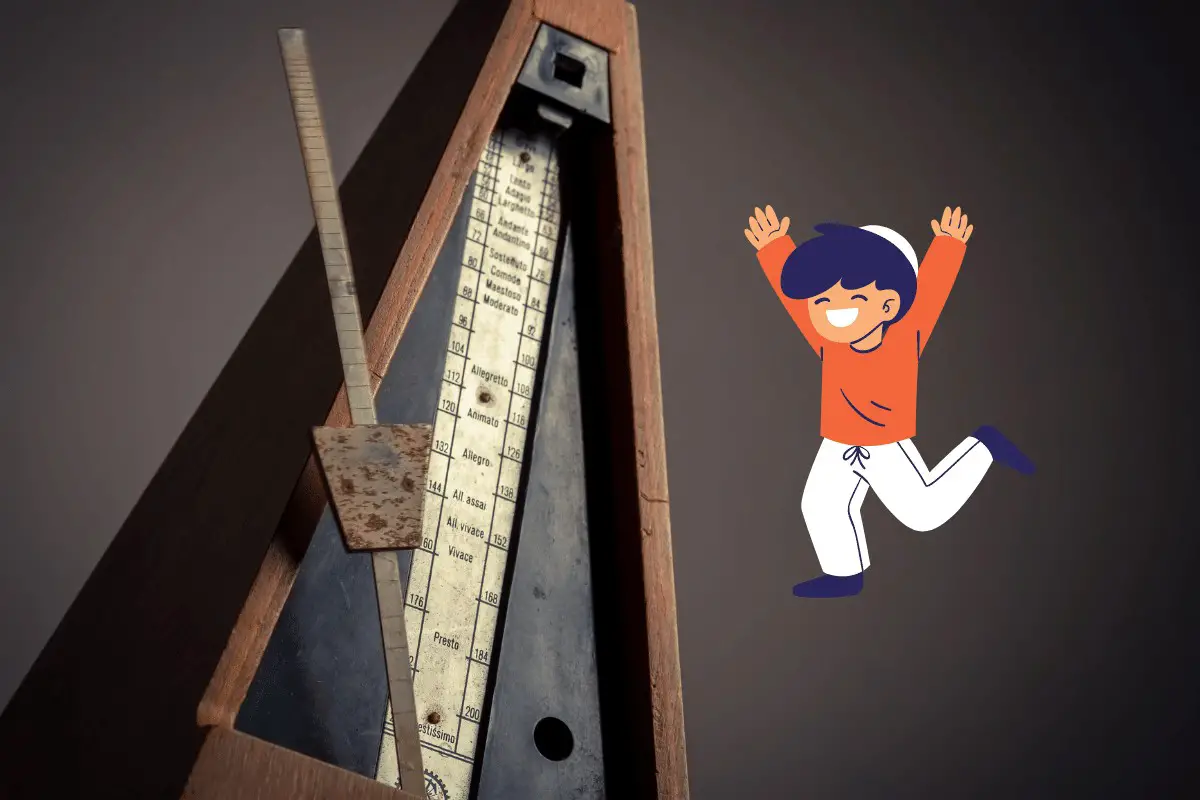Tempo is one of the best and most important elements of music to cover with your students.
But a lot of folks come up blank when it comes to teaching tempo in elementary students.
(Or maybe you just want some new activities to check out!)
This is why I decided to offer up my favorite activities for teaching tempo in music to use with your students.
Teaching tempo activities need to rotate through different types of learning, including moving, visuals, creativity, and real music! My favorite ones include:
- The Statue Game
- Move To Classical Music
- Follow The Hearts
- Paige’s Train
- Tell A Story
- Wake Up, You Lazy Bones
- Let The Kids Conduct
- Use Icons (Or Real Music Words) To Arrange A Song
- Tempo Flashcards
- The Old Gray Cat
Look ahead for the tempo lesson plans and tips on how to teach the changing speed of the beat.

Save time with these 60 FREE Music Resources to use in your room right away!
Stop searching the whole internet to find good activities. I’ll help you cut to the chase with my favorite 60 FREE resources.
Table of Contents
The Statue Game (K-2)
My go-to for starting to teach about tempo is a game I learned from Paul Rose (my host teacher back in the day) called the Statue Game.
In it, the directions start out pretty simple.
Students walk to the beat of the drum as you play it.
When the drum stops, they must freeze and make a statue shape.
The first time we play it at the start of the year, I’ll just focus on a single tempo with a steady beat.
I like to add another dimension to the game by asking them to make statues with different emotions.
(Great for practicing emotional awareness too!)
But as the year goes on and I start to introduce tempo, I’ll switch up the Statue Game just a bit.
Now, I’ll add in extremes of tempo (fast and slow).
On top of what they had to do before, now they must change their movement activities to match the changing beat!
Pro-tip: Be sure to set up or reinforce safety expectations, especially when moving at a fast tempo.
Move To Classical Music (K-5)
Movement is one of the most effective learning styles for a younger age group.
It helps harness their energy into productive learning.
Movement is also the perfect vehicle for hitting all sorts of other purposes, such as:
- Building coordination
- Develop expression in meaningful ways
- Awareness of Form in music
- Giving them something to occupy their energy while listening to Classical Music
- Activating more areas of the brain
With Classical Music, pick a piece of music with either a fast tempo, a slow tempo, or one that changes widely.
With movement, there are a ton of options you have.
Do a mirror movement game where the kids match your moves (or another leader).
Play a movement freeze game where they make a move that stops when you play a sound or give a signal.
Or even allow free movement and dance!
Pro-tip: Use scarves or bean bags as a movement prop to help those who don’t feel comfortable just moving their bodies.
Here’s a quick set of examples of Classical Music for teaching tempo:
- Fast Tempo: Flight of the Bumblebee by Rimsky-Korsakov
- Slow Tempo: Humoresque by Dvorak
- Changing Tempo: Hungarian Dance No. 5 by Brahms
A lot of the Carnival of the Animals is good for this too.
Follow The Hearts (K-1)

Music teachers must go beyond movement to build awareness of a musical concept, such as tempo.
I like to use simple visuals that represent what tempo actually is.
It’s a great way of accessing another learning style.
Of course, using an icon of a turtle for slow speed of tempo and a rabbit for fast is always an option, but I want to dig a little deeper.
While these types of pictures help us figure out what to perform, it doesn’t really represent what tempo actually is.
So what is tempo?
Tempo is the speed of the beat.
The fast tempo has smaller beats.
The slow tempo has larger beats.
I like to show this to my students with simple hearts.
During our initial steady beat practice, I’ll show them shapes to represent the beat and how the same-sized shapes are nice and even and, thus, the steady beat.
For tempo, I show hearts of different sizes.
They still need to be even and similarly sized, but they change size from one tempo to another.
After showing them, they follow along by pointing and performing a song they know well at different tempos.

Save time with these 60 FREE Music Resources to use in your room right away!
Stop searching the whole internet to find good activities. I’ll help you cut to the chase with my favorite 60 FREE resources.
Paige’s Train (K-3)
There are a few folks with specifically changing tempo.
The majority of songs can be made into tempo practice by changing the speed, but Paige’s Train is one that alternates between fast and slow tempi.
Here are the lyrics for the variant I like to sing:
1. Paige’s train goes so slow
Takes so long to get to Buffalo.
———–
2. Paige’s train goes so fast
Trees and houses flying past.
———–
3. Paige’s train climbs the hill
Will she make it? I hope she will.
———–
4. Paige’s train going down
Bringing toys to the town.
Perform the beat in different ways on your body, play instruments, and mix the order of the verses for more practice.
The notation or sheet music may be found in the American Folk Song collection.
Pro-tip: Read The Little Engine That Could as part of this song. It kind of goes along with it.
Songs are the best way to teach musical tempo because you’re doing it at the moment.
Tell A Story (K-5)
Telling a story with naturally changing speed or tempo is one of the easiest ways to hit this concept too.
Pick a story with a changing speed, then add a song that fits the story.
For example, tell the story of the Tortoise and the Hare and then add a song or chant that fits the story.
Students can sing along with the story, play instruments, or act out the story for extensions and more practice.
Many Orff projects include stories, and changing tempi would be perfect here too.
Alternatively, take a song with some change in tempo (like Baby Shark) and fill it out into a story.
Ask the kids to help you out with the story creation too!
They often come up with really cool stuff!
Wake Up You Lazy Bones (1-3)
Here’s another great song for teaching tempo.
(It’s also one of my favorite songs of all time.)
It has two main contrasting sections for tempo (and meter or time signature, too!).
See the notation below, but click over to our dedicated page for the game and a sample music lesson plan for Wake Up You Lazy Bones.

Let The Kids Conduct (K-5)
Let the kids take a leadership role in conducting and picking the tempo.
Students love the thrill of everyone following their directions, and it’s a unique way to really push their tempo skills.
Take a simple song the class knows well and invite someone up to conduct the tempo.
With a younger grade level, I have them “conduct” by pointing at fast and slow pictures and giving us a cut-off at the end.
With older students, I want them to conduct a little more.
If they don’t really know the meter yet, it’s a simple up and down motion for the beat.
If they have a good grasp on the meter, I’ll have them practice conducting as part of those music lessons, so it works to add in changing tempo with what they already know.
At this point, it almost becomes like a tempo music game as the conductor tries to trick the class.
Use Icons (Or Real Music Words) To Arrange A Song (K-5)
Compose or arrange a well-known song into a form with different speeds using icons or real tempo words.
For younger kids, I’ll give them cards with pictures of a fast, medium, and slow tempi.
This will either be a turtle, a person walking, or a rabbit, OR I’ll use the heart examples from before.
Then, they organize the pictures into an order of their choice.
Then, they’ll share their arrangement with the class.
For older kids, I’ll have a well-known song printed off (and laminated if possible).
The students then have to pick where they’ll change the tempo and write down the words where the tempo will change.
Then, they perform for the class.
This works well in small groups or in their own way.
Check out these other music activities for kids.
Tempo Flashcards (2-5)
Flashcards aren’t the most “flashy” of lessons (pun intended), but they work very well for quick practice on a simple recall skill.
With older kids, use tempo flashcards to cover the music terms or tempo markings you want them to know.
Just be sure to cover up any tempo posters you may have.
Come up with different cards to help practice tempo terms based on grade level.
Here are some common ones to consider:
| Tempo Terms | Meaning |
|---|---|
| Presto | Very fast |
| Allegro | Fast |
| Moderato | Moderate, walking |
| Andante | Slow |
| Largo | Very slow |
| Accelerando | Get faster |
| Ritardando | Get slower |
| A tempo | Return to the previous tempo |
The Old Gray Cat (K-2)
For the last activity on my list, I chose another song and game.
Use all sorts of different songs for further reinforcement.
The song is about mice who are sneaking around the cat.
During the cat verses, you sing them slowly and softly.
During the mouse verses, you sing quicker.
When the cat wakes up, the tempo of the music goes very fast.
This also makes a great chase game.
Have one or two “cats” sleep in the middle of the room.
As the song goes on, the rest of the students are mice and must creep around the room.
When the cats wake up, they have to chase and tag the mice as they run home to the “safe zone.”
Tagged mice become cats.
Repeat until everyone is a cat or you run out of time.
Check out this video for an example of how it’s supposed to go.

Save time with these 60 FREE Music Resources to use in your room right away!
Stop searching the whole internet to find good activities. I’ll help you cut to the chase with my favorite 60 FREE resources.

